GETTING STARTED.
Match these stages in the development of paper with the correct pictures.
(Hãy ghép các giai đoạn phát triển của giấy đúng với những bức tranh sau.)
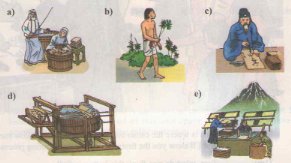
A. Five thousand years ago, the Egyptians wrote on a plant called papyrus.
B. A Chinese official made paper from wood pulp in the year 105.
C. The Japanese learned how to make paper in the seventh century.
D. In 768, Arabs learned about papermaking from Chinese prisoners.
E. The first papermaking machine was invented in the late 1700s by a Frenchman.
Hướng dẫn giải:
A - b
B - c
C - e
D - a
E - d
Tạm dịch:
A. Năm ngàn năm trước, người Ai Cập đã viết trên một loài thực vật tên là giấy cói.
B. Người Trung Quốc chính thức làm giấy từ bột giấy gỗ vào năm 105.
C. Người Nhật học được cách làm giấy vào thế kỷ thứ bảy.
D. Vào năm 768, người Ả Rập học làm giấy từ các tù nhân Trung Quốc.
E. Máy làm giấy đầu tiên được phát minh vào cuối những năm 1700 bởi một người Pháp.
LISTEN AND READ.
1. Practice the dialogue with a partner.
(Hãy luyện tập hội thoại với bạn em.)
Click tại đây để nghe:
Tim Jones, Hoa’s American pen pal is visiting a chocolate factory with his class and his teacher, Mrs. Allen. Mr. Roberts, the factory foreman, is showing them around.
Mr. Roberts: This is where the cacao beans are stored. Now follow me and I’ll show you the first step in the manufacturing process.
Tim: Sam, what do you think this button is for?
Sam: I have no idea.
Mrs. Allen: Tim! Sam! Come here!
Mr. Roberts: Children, don’t touch that button! Now, the beans are washed, weighed, and cooked here.
Mrs. Allen: Tim, come and stand beside me. I told you to behave!
Mr. Roberts: After the shells are removed, the beans are crushed and liquified. Cocoa butter is added, alone with sugar, vanilla and milk. Then the mixture is ground, rolled and poured into molds.
Tim: It looks delicious.
Sam: Can we taste any?
Mr. Roberts: Yes, there’s some beside the conveyor belt.
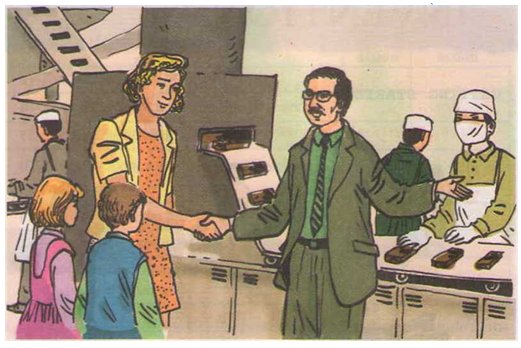
Bài dịch:
Tim Jones, người bạn quen biết qua thư từ của Hoa, đang thăm một nhà máy chế biến sô-cô-la cùng với lớp cậu ấy và cô Allen. Quản đốc Robert, đang dẫn họ đi xem quanh nhà máy.
Mr. Roberts: Đây là nơi bảo quản hạt ca-cao. Còn bây giờ hãy theo tôi, tôi sẽ chỉ cho các bạn xem bước đầu tiên của quá trình sản xuất.
Tim: Sam, theo bạn cái nút này để làm gì?
Sam: Mình không biết.
Mrs. Allen: Tim, Sam lại đây các em.
Mr. Roberts: Các cháu này, cái nút kia không sờ vào được đâu. Lúc này những hạt ca-cao đang được rửa sạch, đem lên cân rồi chế biến ở đây.
Mrs. Allen: Tim, em lại đây đứng gần cô. Cô đã dặn em rồi mà.
Mr. Roberts: Sau khi tách vỏ ra, hạt ca-cao được đưa vào xay và ép ra nước. Người ta thêm bơ cô-ca cùng với đường, va-ni và sữa. Sau đó hỗn hợp này được nghiền ra rồi được cán và đổ ra khuôn.
Tim: Trông ngon quá.
Sam: Chúng cháu nếm thử được không ạ?
Mr. Roberts: Được chứ. Có một ít ở trên băng chuyền kia kìa.
2. Match the half-sentences. Then write the full sentences in your exercise book.
(Hãy ghép các nửa câu lại với nhau thành câu đầy đủ rồi chép vào vở bài tập.)
a) The beans are cleaned A. the cacao beans smell like chocolate.
b) Mr. Roberts thought B. one of the ingredients in chocolate.
c) After cooking, C. Tim and Sam were going to touch the button.
d) Sugar is D. before being cooked.
Hướng dẫn giải:
a - D The beans are cleaned before being cooked.
b - C Mr. Roberts thought Tim and Sam were going to touch the button.
c - A After cooking, the cocoa beans smell like chocolate.
d - B Sugar is one of the ingredients in chocolate.
Tạm dịch:
a. Các hạt đậu được làm sạch trước khi nấu chín.
b. Ông Roberts nghĩ Tim và Sam sẽ chạm vào nút.
c. Sau khi nấu, hạt cacao có mùi như sô cô la.
d. Đường là một trong những thành phần trong sô cô la.
SPEAK.
1. Work with a partner. Student A looks at the table next page. Student B looks at the table at the end of this unit (page 156). Ask and answer questions to fill in the missing information in your tables.
(Hãy làm việc với bạn bên cạnh. Học sinh A nhìn bảng ở trang sau. Học sinh B nhìn bảng ở cuối bài học này (trang 156). Hãy hỏi và trả lời để điền những thông tin còn thiếu vào bảng của em.)
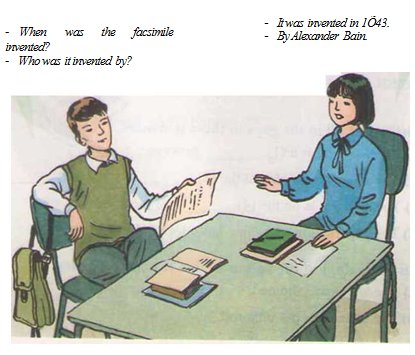
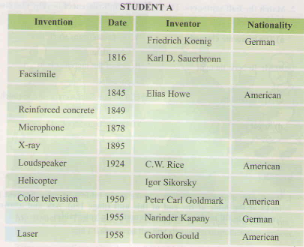
Hướng dẫn giải:
A: When was the bicycle invented?
B: It was invented in 1816.
A: Who was it invented by?
B: By Frederick Koenig.
A: What was his nationality?
B: He was German.
A: When was the color television invented?
B: It was invented in 1950.
A: Who was it invented by?
B: By Peter Carl Goldmark.
A: What was his nationally?
B: He was American.
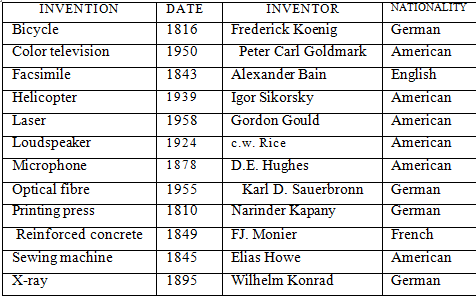
Tạm dịch:
A: Xe đạp được phát minh khi nào?
B: Nó được phát minh vào năm 1816.
A: Nó được đã được phát minh bởi ai?
B: Frederick Koenig.
A: Quốc tịch của ông ấy là gì?
B: Ông ấy là người Đức.
A: Tivi màu đượ phát minh khi nào?
B: Nó được phát minh vào năm 1950.
A: Nó được đã được phát minh bởi ai?
B: Bởi Peter Carl Goldmark.
A: Quốc tịch của ông ấy là gì?
B: Ông ấy là người Mỹ.
Phát minh | Thời gian | Nhà phát minh | Quốc tích |
Xe đạp | 1816 | Frederick Koenig | Đức |
Tivi màu | 1950 | Peter Carl Goldmark | Mỹ |
Máy fax | 1843 | Alexander Bain | Anh |
Trực thăng | 1939 | Igor Sikorsky | Mỹ |
Tia laze | 1958 | Gordon Gould | Mỹ |
Loa | 1924 | C.W. Rice | Mỹ |
Mi-crô | 1878 | D.E.Hughes | Mỹ |
Cáp quang | 1955 | Karl D. Sauerbronn | Đức |
Báo in | 1810 | Narinder Kapany | Đức |
Bê tông cốt thép | 1849 | FJ. Monier | Pháp |
Máy may | 1845 | Elias Howe | Mỹ |
Tia X | 1895 | Wilhelm Knorad | Đức |
2. Now report your findings to the teacher.
(Hãy thuật lại những điều em đã biết với thầy/cô giáo.)
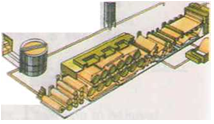
The facsimilie was invented by Alexander Bain in 1843.
The bicycle was invented by Ferderick Koenig in 1816.
The color television was invented by Peter Carl Goldmark in 1950.
The helicopter was invented by Igor Sikorsky in 1939.
The laser was invented by Gordon Gould in 1958.
The loudspeaker was invented by c.w. Rice in 1924.
The microphone was invented by D.E. Hughes in 1878.
The optical fibre was invented by Karl D. Sauerbronn in 1955.
The printing press was invented by Narinder Kapany in 1810.
The reinforced concrete was invented by F.J. Monier in 1849.
The sewine machine was invented by Elias Howe in 1845.
The X-ray was invented by Wilhelm Konrad in 1895.
Tạm dịch:
Máy fax được phát minh bởi Alexander Bain năm 1843.
Chiếc xe đạp được phát minh bởi Ferderick Koenig vào năm 1816.
Tivi màu được phát minh bởi Peter Carl Goldmark vào năm 1950.
Chiếc trực thăng được phát minh bởi Igor Sikorsky vào năm 1939.
Laser được phát minh bởi Gordon Gould vào năm 1958.
Loa được phát minh bởi c.w. Rice năm 1924.
Micro được phát minh bởi D.E.Hughes năm 1878.
Sợi quang được phát minh bởi Karl D. Sauerbronn vào năm 1955.
Báo in được phát minh bởi Narinder Kapany năm 1810.
Bê tông cốt thép được phát minh bởi F.J. Monier năm 1849.
Máy khâu được Elias Howe phát minh vào năm 1845.
Tia X được phát minh bởi Wilhelm Konrad vào năm 1895.
LISTEN.
Click tại đây để nghe:
1. Listen and fill in the gaps in these sentences.
(Nghe và điền vào chỗ trống trong những câu sau đây.)
a) Papermaking is a (1)_______ process.
b) The procedure is almost the (2) _____ as it was (3) ________ years ago.
c) The pulp vat is on the (4)________ of the machine.
d) The papermaking machine has a lot of (5)_______ .
Hướng dẫn giải:
a) Papermaking is a (1) simple process.
b) The procedure is almost the (2) same as it was (3) 200 years ago.
c) The pulp vat is on the (4) left of the machine.
d) The papermaking machine has a lot of (5) rollers.
Tạm dịch:
a) Làm giấy là một quá trình đơn giản.
b) Quá trình gần giống như cách đây 200 năm.
c) Thùng giấy ở phía bên trái của máy.
d) Máy sản xuất giấy có rất nhiều con lăn.
Audio script:
Paper making is a simple process. The procedure is almost the same as it was 200 years ago. Look closely at this picture of an old paper making machine on the left of the pulp vat. Paper pulp was placed in the vat and mixed with a lot of water. The water was then drained and the pulp fibers were poured out of the vat and onto a conveyor belt took them under the rollers. There were quite a lot of rollers as you can see. These rollers smoothed the fibers and pressed them dry. The finished paper was then put on a roll at the end. You can see the roll of paper at the far right of the picture.
Bài dich:
Làm giấy là một quá trình đơn giản. Quá trình này gần giống như cách đây 200 năm. Quan sát kỹ bức ảnh của chiếc máy làm giấy cũ ở bên trái thùng đựng bột giấy. Bột giấy được đặt trong thùng và trộn với nhiều nước. Nước sau đó đã được rút ra và các sợi bột giấy được đổ ra khỏi thùng và trên một băng tải đưa chúng xuống dưới các con lăn. Có khá nhiều con lăn như bạn có thể thấy. Những con lăn này làm nhẵn sợi và ép chúng khô. Giấy đã làm xong thành sau đó được đưa cuốn thành một cuộn ở cuối. Bạn có thể thấy cuộn giấy ở phía xa bên phải của bức ảnh.
2. Listen again. Put the sentences into the correct order.
(Nghe lại lần nữa và xếp những câu sau đây theo đúng thứ tự.)
Click tại đây để nghe:
a) The water was drained.
b) The paper was put on a roll.
c) Paper pulp was placed in the vat.
d) Paper pulp was mixed with water.
e) The pulp fibers were poured out.
f) The fibers were smoothed and pressed dry.
g) The pulp was conveyed under the rollers.
Hướng dẫn giải:
c) Paper pulp was placed in the vat.
d) Paper pulp was mixed with water.
a) The pulp fibers were poured out.
g) The pulp was conveyed under the rollers.
f) The fibers were smoothed and pressed dry.
b) The paper was put on a roll.
Tạm dịch:
c) Bột giấy được để trong thùng.
d) Bột giấy được trộn với nước.
a) Các sợi bột giấy được đổ ra ngoài.
g) Bột giấy được chuyển vào dưới con lăn.
f) Các sợi được làm nhẵn và ép khô.
b) Giấy được cuốn thành một cuộn.
READ.
Click tại đây để nghe:
Read the following poem about inventions.
(Đọc bài thơ sau về các phát minh.)
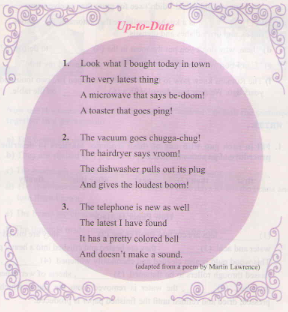
Dịch bài:
1. Hãy nhìn xem hôm nay tôi đã mua gì ở thị trấn
Những thứ mới nhất
Một lò vi ba kêu be-doom!
Một máy nướng bánh mì kêu lanh canh!
2. Máy hút bụi nổ bình bịch!
Máy sấy tóc kêu vroom!
Máy rửa bát sút phích cắm
Và kêu ầm ĩ rất to!
3. Máy điện thoại cũng tân tiến
Là cái mới nhất mà tôi đã tìm thấy
Nó có một cái chuông màu xinh xắn
Nhưng không phát ra âm thanh.
Phỏng theo một bài thơ của Martin Lawrence
1. Match the headings to the verses.
(Ghép các tiêu đề với các đoạn thơ.)
Verse 1 a. Instrument invented by Alexander Graham Bell
Verse 2 b. Appliances that cook food
Verse 3 c. Appliances that clean or dry things
Hướng dẫn giải:
Verse 1 - b) Appliances that cook food.
Verse 2 - c) Appliances that clean or dry things.
Verse 3 - a) Instrument invented by Alexander Graham Bell.
Tạm dịch:
Đoạn 1 - b) Các thiết bị nấu thức ăn.
Đoạn 2 - c) Các thiết bị làm sạch hoặc khô.
Đoạn 3 - a) Công cụ được phát minh bởi Alexander Graham Bell.
2. Fill in each of the gaps in the sentences with one "invention" in the poem.
(Điền vào chỗ trống trong những câu dưới đây bằng một "phát minh" trong bài thơ trên.)
a) “Joan, where’s the (1)_________ ? I want to clean the floor.”
b) Last night I was reading in the bedroom when the (2)______ rang. It was Ann, an old friend I didn’t see for more than twelve years.
c) A (3)_________ is a kitchen appliance that automatically washes, rinses, and dries dishes and utensils.
d) “Jane, why don’t you put the meat in the (4)_________ to defrost it?”
e) “Can I borrow your (5)__________ ? I've just washed my hair.”
f) The Romans knew how to toast bread over an open fire two thousand years ago. We now toast bread with a (6)___________ on the table.
Hướng dẫn giải:
a) "Joan, where's the (1) vacuum? I want to clean the floor."
b) Last night I was reading in the bedroom when the (2) telephone rang. It was Ann, an old friend I didn't see for more than twelve years.
c) A (3) washing machine is a kitchen appliance that automatically washes, rinses, and dries dishes and utensils.
d) "Jane, why don't you put the meat in the (4) microwave to defrost it?"
e) "Can I borrow your (5) hairdryer? I've just washed my hair."
f) The Romans knew how to toast bread over an open five two thousand years ago. We now toast bread with a (6) toaster on the table.
Tạm dịch:
a) "Joan, máy hút bụi ở đâu rồi? Tôi muốn lau sàn."
b) Đêm qua tôi đã đọc sách trong phòng ngủ khi điện thoại reo. Đó là Ann, một người bạn cũ mà tôi đã không gặp trong hơn mười hai năm.
c) Máy rửa bát là thiết bị nhà bếp có thể tự động rửa và phơi khô bát đĩa và một số thứ khác.
d) "Jane, sao bạn không cho thịt vào lò vi sóng để rã đông nó?"
e) "Tôi có thể mượn máy sấy tóc của bạn không? Tôi vừa gội đầu."
f) Người La Mã biết cách nướng bánh mì vào năm ngàn năm trước. Bây giờ chúng ta nướng bánh mì với một máy nướng bánh mì trên bàn.
WRITE.
1. Fill in each gap with one of these sequence markers to describe the procedure of papermaking.
(Điền vào mỗi chỗ trống bằng từ nối để mô tả quy trình sản xuất giấy.)
first then (2) next after this finally
How Paper Is Made
(1) ________, logs are cut into small chips. (2)_______________ they are mixed with water and acid (3)________ they are heated and crushed into a heavy pulp. This wood pulp is also cleaned and chemically whitened. (4)________ it is passed through rollers to be flattened. (5)________ . sheets of wet paper are produced. (6)_______ . the water is removed from the sheets which are pressed, dried and refined until the finished paper is produced
Hướng dẫn giải:
How Paper Is Made
(1) First, logs are cut into small chips. (2) Then they are mixed with water and acid. (3) Next they are heated and crushed to a heavy pulp. This wood pulp is also cleaned and chemically whitened. (4) After this, it is passed through rollers to be flattened. (5) Then, sheets of wet paper are produced. (6) Finally, the water is removed from the sheets which are pressed, dried and refined until the finished paper is produced.
Tạm dịch:
Giấy được tạo ra như thế nào
(1) Đầu tiên, gỗ được thái thành các lát nhỏ. (2) Sau đó chúng được trộn với nước và axit. (3) Tiếp theo chúng được đun nóng và nghiền thành bột giấy nặng. Bột gỗ này cũng được làm sạch và làm trắng hóa học.(4) Sau đó, nó được truyền qua các con lăn để được làm phẳng. (5) Sau đó, các tờ giấy ướt được sản xuất. (6) Cuối cùng, nước được lấy ra khỏi các tấm được ép, sấy khô và tinh chế cho đến khi sản phẩm giấy hoàn chỉnh được sản xuất.
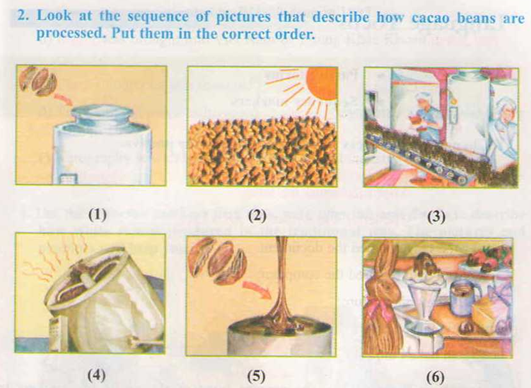
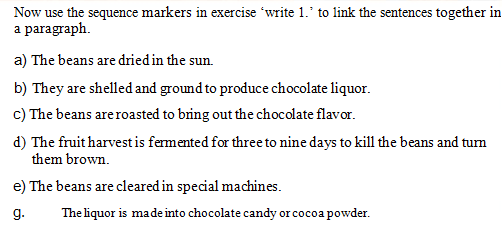
2. Look at the sequence of pictures that describe how cacao beans are processed. Put them in the correct order.
(Nhìn tranh mô tả quá trình chế biến hạt ca-cao rồi xếp đúng thứ tự các bức tranh.)
Hướng dẫn giải:
1 - d) The fruit harvest is fermented for three to nine days to kill the beans and turn them brown.
2 - a) The beans are dried in the sun.
3 - e) The beans are cleared in special machines.
4 - c) The beans are roasted to bring out the chocolate favour.
5 - b) They are shelled and ground to produce chocolate liquor.
6 - f) The liquor is made into chocolate candy or cocoa powder.
Now use the sequence markers in exercise 'write 1' to link sentences together in a paragraph.
(Bây giờ hãy dùng từ nối ở bài tập 1 để nối các câu trên lại với nhau thành một đoạn văn.)
At first, the fruit harvest is fermented for three to nine days to kill the beans and turn them brown. Then, the beans are dried in the sun. Next, the beans are cleured in special machines. After this, the beans are roasted to bring out the chocolate favour. Then, they are shelled and ground to produce chocolate liquor. Finally, the liquor is made into chocolate candy or cocoa powder.
Tạm dịch:
Lúc đầu, vụ thu hoạch trái cây được lên men từ ba đến chín ngày để làm rụng hạt và biến chúng thành màu nâu. Sau đó, hạt được sấy khô dưới ánh mặt trời. Tiếp theo, các hạt được bào chế trong các loại máy đặc biệt. Sau đó, các hạt được rang để lấy hương vị sô cô la. Sau đó, chúng được bóc vỏ và nghiền để sản xuất chất lỏng sô cô la. Cuối cùng, chất lỏng được làm thành kẹo sô-cô-la hoặc bột cacao.
Language Focus
● Passive forms
● Sequence markers
1. Change the sentences from the active into the passive.
(Chuyển câu chủ động sang câu bị động.)
Example:
Miss Lien wrote the letter.
=> The letter was written by Miss Lien.
a) Mrs. Quyen typed the document.
b) Mr. Nhan repaired the computer.
c) Ba drew the picture.
d) Hoa turned off the lights.
e) Lan baked the cake.
Hướng dẫn giải:
a) The documents was typed by Mrs. Quyen.
b) The computer was repaired by Mr. Nhan.
c) The picture was drawn by Ba.
d) The lights were turned off by Hoa.
e) The cake was baked by Lan.
Tạm dịch:
Ví dụ: Cô Liên đã viết thư.
=> Bức thư đã được viết bởi Miss Lien.
a) Bà Quyền đã gõ văn bản.
=> Các tài liệu đã được gõ bởi bà Quyền.
b) Ông Nhân đã sửa máy tính.
=> Máy tính đã được sửa bởi ông Nhân.
c) Ba đã vẽ bức tranh.
=> Hình ảnh đã được vẽ bởi Ba.
d) Hoa đã tắt đèn.
=> Đèn đã được tắt bởi Hoa.
e) Lan đã nướng bánh.
=> Bánh đã được nướng bởi Lan.
2. Active or Passive? Use the correct form of the verbs in brackets to complete these sentences.
(Chủ động hay Bị động? Hoàn thành câu bằng dạng đúng của động từ trong ngoặc.)
a) The grand prize________ to the Hoa Vinh Village team. (award)
b) Viet Nam_____ two gold medals on the first day of the Games. (win)
c) Last year Mrs. Jackson____ a small business around the corner. (run)
d) The factory__________ by Quang Vinh Ltd. before it__________ to a foreign firm. (run / sell)
e) Thanh Ha School______ for two days last week due to a flood, (close)
Hướng dẫn giải:
a. The grand prize was awarded to Hoa Vinh Village team.
b. Viet Nam won two gold medals on the first day of the Games.
c. Last year Mrs. Jackson ran a small business around the corner.
d. The factory was run by Quang Vinh Ltd. before it was sold to a foreign firm.
e. Thanh Ha School was closed for two days last week due to a flood.
Tạm dịch:
a. Giải thưởng lớn đã được trao cho đội Làng Hoa Vinh.
b. Việt Nam đã giành hai huy chương vàng vào ngày đầu tiên của Thế vận hội.
c. Năm ngoái bà Jackson điều hành một doanh nghiệp nhỏ
d. Nhà máy được điều hành bởi Công ty TNHH Quang Vinh trước khi nó được bán cho một công ty nước ngoài.
e. Trường Thanh Hà bị đóng cửa hai ngày cuối tuần do lũ lụt.
3. Put a question for each of the underlined phrases in the sentences below.
(Đặt câu hỏi cho những từ được gạch chân trong những câu dưới đây.)
Example:
The facsimile was invented by Alexander Bain in 1843.
When was the facsimile invented?
a) The zipper was invented bv W.L. Judson in 1893.
b) Maize was brought into Viet Nam by Phung Khac Khoan in the 16th century.
c) The fountain pen was invented by Lewis Waterman in 1884.
d) The ballpoint pen was invented in Hungary by brothers Lazio and Georg Biro in 1935.
e) Xerography is widely used in commerce and industry in copying machines.
Hướng dẫn giải:
a. What was invented by W.L. Judson in 1893?
b. What was brought into Viet Nam by Phung Khac Khoan? When was it invented?
c. Who was the fountain pen invented by? When was it invented?
d. Where was the ballpoint pen was invented in 1935 by brothers Lazio and George Biro?
e. Where is Xeroraphy widely used in commerce and industry?
Tạm dịch:
Ví dụ: Máy fax được Alexander Bain phát minh năm 1843.
- Máy fax được phát minh khi nào?
a) Bật lửa được phát minh bv W.L.Judson năm 1893.
- Cái gì được phát minh bởi W. L. Judson vào năm 1893?
b) Giống ngô đã được Phùng Khắc Khoan được đưa vào Việt Nam vào thế kỷ 16.
- Phùng Khắc Khoan đưa vào Việt Nam cái gì?
- Nó được phát minh khi nào?
c) Cây bút mực được phát minh bởi Lewis Waterman vào năm 1884.
- Cây bút được phát minh ra bởi ai?
- Nó được phát minh khi nào?
d) Bút bi được phát minh ở Hungary bởi hai anh em Lazio và Georg Biro vào năm 1935.
- Bút bi được phát minh vào năm 1935 bởi anh em Lazlo và George Biro ở đâu?
e) Phương pháp in chụp tĩnh điện được sử dụng rộng rãi trong thương mại và công nghiệp trong các máy phô tô.
- Phương pháp in chụp tĩnh điện được sử dụng rộng rãi trong thương mại và công nghiệp ở đâu?
4. Use the sequence markers first, then, next, after this and finally to describe how white rice is produced in the traditional way. The pictures and prompts will help you.
(Dùng các từ nối first, then, next, after this và finally mô tả quy trình sản xuất gạo trắng theo kiểu truyền thống. Những bức tranh và gợi ý sẽ giúp em.)

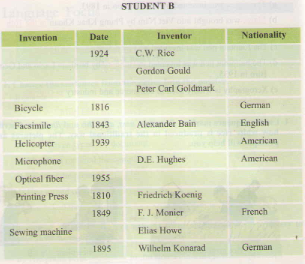
Hướng dẫn giải:
At first, the rice crop is harvested. Next, the rice plants are threshed. Then, the rice grains are separated from the husk and put into the mill to produce brown rice. After this, the bran is removed by the mortar. Finally, it is winnowed to produce white rice.
Tạm dịch:
Đầu tiên, vụ lúa được thu hoạch. Tiếp theo, các cây lúa được đập. Sau đó, các hạt gạo được tách ra từ trấu và đưa vào nhà máy để sản xuất gạo lứt. Sau đó, cám được đưa ra khỏi cối. Cuối cùng, nó được sảy để sản xuất gạo trắng.
Tổng hợp từ vựng (Vocabulary) SGK tiếng Anh lớp 8 unit 16
UNIT 16. INVENTIONS
Các phát minh
- microphone /ˈmaɪkrəfəʊn/(n): mi crô
- X-ray /reɪ/(n): tia X
- loudspeaker /ˌlaʊdˈspiːkə(r)/(n): loa phóng thanh
- papyrus /pəˈpaɪrəs/(n): cây cói giấy, giấy cói
- helicopter /ˈhelɪkɒptə(r)/(n): máy bay lên thẳng
- pulp /pʌlp/(n): bột giấy
- laser /ˈleɪzə(r)/(n): tia la de
- procedure /prəˈsiːdʒə(r)/(n): tiến trình
- foreman /ˈfɔːmən/(n): quản đốc
- drain /dreɪn/(v): làm rút nước, tháo nước
- cacao /kəˈkaʊ/(n): ca cao
- fiber /ˈfaɪbə(r)/(n): sợi, chất xơ
- manufacture /ˌmænjuˈfæktʃə(r)/(v): sản xuất, chế biến
- microwave /ˈmaɪkrəweɪv/(n): vi sóng
- vacuum /ˈvækjuəm/(n): máy hút bụi, chân không
- crush /krʌʃ/(v): nghiền nát
- rinse /rɪns/(v): giũ (quần áo)
- liquefy /ˈlɪkwɪfaɪ/(v): làm cho thành nước
- utensil /juːˈtensl/(v): đồ dùng (nhà bếp)
- defrost /ˌdiːˈfrɒst/(v): làm tan giá đông
- vanilla /vəˈnɪlə/(n): vani
- chip /tʃɪp/(n): miếng nhỏ, mảnh nhỏ
- mixture /ˈmɪkstʃə(r)/(v): trộn
- refine /rɪˈfaɪn/(v): lọc trong, tinh luyện, tinh chế
- mold /məʊld/(n): cái khuôn đúc
- liquor /ˈlɪkə(r)/(n): rượu, nước dùng
- conveyor-belt /kənˈveɪə belt/(n): băng tải, băng truyền
- ferment /fəˈment/(v): lên men
- sample /ˈsɑːmpl/(n): vật mẫu, mẫu vật
- ingredient /ɪnˈɡriːdiənt/(n): thành phần
- zipper (AE), zip (BE): khóa kéo
- facsimile /ˈzɪpə(r)/(n): máy fax
- ballpoint pen /ˈbɔːlpɔɪnt/(n): bút bi
- thresh /θreʃ/(v): đập (lúa)
- mortar /ˈmɔːtə(r)/(n): cối giã (gạo)
- winnow /ˈwɪnəʊ/(v): sàng sẩy, thổi bay
- mill /mɪl/(n): cối xay
- grind /ɡraɪnd/(v): xay nhỏ
- process /ˈprəʊses/(n): qui trình, quá trình
- reinforced concrete /ˌriːɪnˈfɔːs - ˈkɒŋkriːt/(n): bê tông cốt thép






0 Nhận xét